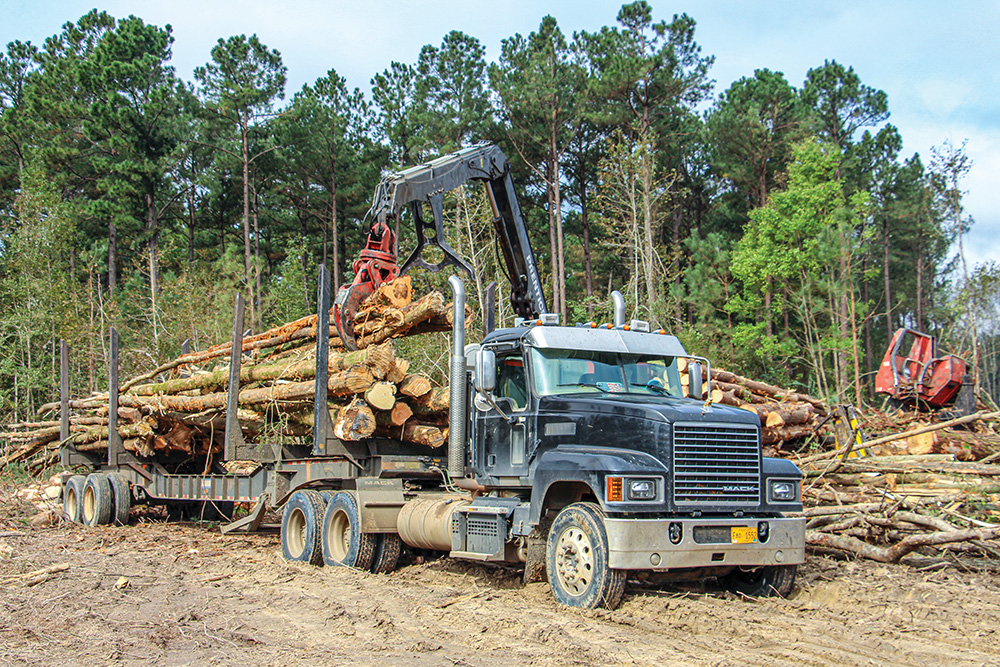Southern Pulpwood Producers Should Watch Markets Closely
Article by Dan Shell, Managing Editor, Timber Harvesting January/February 2024
Going into the holidays after a fall of extremely dry weather from Labor Day to Thanksgiving that left wood yards and log yards as full as they wanted to be, pulpwood producers in the primary pulp and paper region of the Southeast struggle with mill and machine closures that are leading to a historic reset in U.S. paper-packaging manufacturing and especially a reduction in roundwood utilization that has broad implications for raw material supply chains.
International Paper in October announced a containerboard mill closure in Texas and permanent closure of pulp machines at mills in North Carolina and Florida. In addition to affecting 900 jobs, the move eliminates an estimated 5 million green tons of wood fiber capacity across three mills. And the IP announcement is just the latest: Since January 2023, at least seven permanent U.S. mill or machine closures have been announced, according to North American Woodfiber & Biomass Markets newsletter.
The cumulative impact of pulp and paper facility closures across North America on the timber industry and its raw materials supply chain is historic and can’t be overstated, the newsletter states, as an estimated 15 million tons of roundwood and chip consumption have been taken off the market in 2023-about 17% of total wood consumption in 2022.

The newsletter notes that beginning with five announcements in 2020, during the past four years there’s been a total of 22 major U.S. pulpwood mill and machine closures that have taken a cumulative 30 million green tons a year in log and chip consumption off the market.
Those numbers are unprecedented, and each closure represents a whittling down of needed logging capacity for that facility that ripples through a given procurement area. Multiple news reports from the regions affected tell stories of longtime employers no longer there, and families and companies uncertain of the future. In fact, the numbers are such that big impacts can be expected up and down the supply chain, from loggers looking for a place to haul and and even mills having difficulty moving residuals.
There are big implications for such a shift in demand that are just beginning to sink in as the supply chain adjusts. Meanwhile the most recent newsletter from mid December reports U.S. Forest Service data through 2022 that show roundwood as a primary raw material in 13 Southern states has slipped from 82% of total pulp manufacturing raw materials in 2015 to 75% in 2022. That’s a big number, and for loggers in certain markets and wood baskets, it’s even bigger.
From Virginia to Texas, six of the 13 Southern states accounted for 72 % of the South’s total 2022 pulpwood production of 147.9 million tons. Yet the top three states’ 2022 pulpwood output represented a combined 11 % reduction from 2021: Alabama-23.9 million tons, down 5%; Georgia-23.4 million tons, down 4 %; and Mississippi-18.3 million tons, down 2%.
The states with the largest decrease in pulpwood production from 2021 to 2022? Tennessee, down 41 %; Oklahoma, down 22%, Texas, down 18%; and Florida, down 16%.
Detailing those reductions in output by species, FS research noted Southern hardwood pulpwood production dropped 7% (1.6 million tons), while softwood roundwood production decreased 6% (5.6 million tons) from 2021 to 2022.
The industry is resilient, however, as research shows in 2022 two thirds of the 1,306 counties in 13 Southeast states produced either soft- or hardwood roundwood. And, depending on overall infrastructure and location, OSB plants and wood pellet facilities can take up some of the slack in low demand pulpwood markets (the key word being some.)
But the restructuring and reduced roundwood consumption can’t be ignored and won’t be, and loggers operating with one of the closed mills as a major market can expect a tough 2024.
Latest News
Sierra Pacific Breaks Ground In Eugene
Sierra Pacific Breaks Ground In Eugene Sierra Pacific Industries broke ground on its new state-of-the-art sawmill in Eugene, Ore. in early November. SPI’s Oregon crews joined in celebrating the...
Upgraded From Tigercat: 850B Processor
Upgraded From Tigercat: 850B ProcessorThe 850 processor, the Tigercat branded purpose-built alternative to excavator conversions, has been upgraded for improved performance. The new 850B retains all...
WANT MORE CONTENT?
Spanning seven decades since its inception in 1952, Timber Harvesting highlights innovative and successful logging operations across the U.S. and around the world. Timber Harvesting also emphasizes new technology and provides the best marketing vehicle for the industry’s suppliers to reach the largest number of loggers in North America and beyond.
Call Us: 800.669.5613


